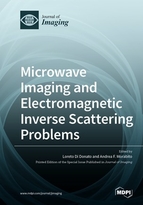Microwave Imaging and Electromagnetic Inverse Scattering Problems
A special issue of Journal of Imaging (ISSN 2313-433X).
Deadline for manuscript submissions: closed (15 March 2019) | Viewed by 52667
Special Issue Editors
Interests: electromagnetic scattering; microwave imaging; array antenna synthesis; plasma diagnostics
Interests: microwave imaging; theranostics; antenna theory and design; satellite and radar systems
Special Issue Information
Dear Colleagues,
Microwave imaging techniques allow to develop systems that are able to inspect, identify, and characterize, in a non-invasive fashion, different scenarios, ranging from biomedical to subsurface diagnostics, from surveillance and security applications to non-destructive evaluation. Such a great chance is actually severely limited by difficulties arising from the solution of the underlying inverse scattering problem. As a result, ongoing research efforts in this area are devoted to achieving inversion strategies and experimental apparatus so that they are as reliable as possible with respect to reconstruction capabilities and resolution performance.
The intent of this Special Issue is to collect the experiences of leading scientists in the electromagnetic inverse scattering community, as well as serving as an assessment tool for people who are new to the area of microwave imaging and electromagnetic inverse scattering problems.
This Special Issue intends to cover the following topics, but is not limited to them:
- Novel microwave imaging approaches
- Exact and approximated methods for microwave imaging
- Qualitative and quantitative methods for microwave imaging
- Local and global approaches for microwave imaging
- Compressive Sensing based microwave imaging
- Experimental facilities and apparatus
- Antennas design for microwave imaging
- Biomedical microwave tomography
- Subsurface imaging and Ground Penetrating Radar (GPR)
- Through-the-wall, Security and Surveillance microwave imaging
- New emerging trends in microwave imaging
- Microwave imaging at THz frequencies
Indeed, works and results concerning the use of microwave imaging and electromagnetic inverse scattering techniques, as well the development of new application procedures, may fall within the scope of this Special Issue. Of course, papers must present novel achievements, or the advancement of previously-published results.
Dr. Loreto Di DonatoDr. Andrea F. Morabito
Guest Editors
Manuscript Submission Information
Manuscripts should be submitted online at www.mdpi.com by registering and logging in to this website. Once you are registered, click here to go to the submission form. Manuscripts can be submitted until the deadline. All submissions that pass pre-check are peer-reviewed. Accepted papers will be published continuously in the journal (as soon as accepted) and will be listed together on the special issue website. Research articles, review articles as well as short communications are invited. For planned papers, a title and short abstract (about 100 words) can be sent to the Editorial Office for announcement on this website.
Submitted manuscripts should not have been published previously, nor be under consideration for publication elsewhere (except conference proceedings papers). All manuscripts are thoroughly refereed through a single-blind peer-review process. A guide for authors and other relevant information for submission of manuscripts is available on the Instructions for Authors page. Journal of Imaging is an international peer-reviewed open access monthly journal published by MDPI.
Please visit the Instructions for Authors page before submitting a manuscript. The Article Processing Charge (APC) for publication in this open access journal is 1800 CHF (Swiss Francs). Submitted papers should be well formatted and use good English. Authors may use MDPI's English editing service prior to publication or during author revisions.
Keywords
- Electromagnetics inverse scattering problems
- Microwave imaging
- Nonlinear optimization for microwave imaging
- Regularization techniques for microwave imaging
- Compressive Sensing for microwave imaging
- Biomedical microwave tomography
- Subsurface microwave imaging
- Ground Penetrating Radar
- Antennas and arrays for microwave imaging








